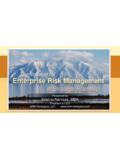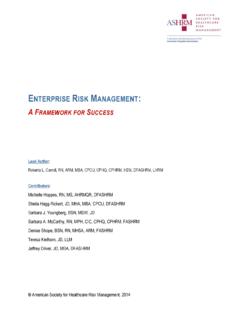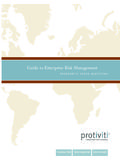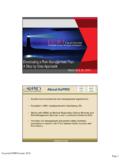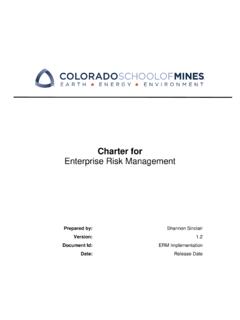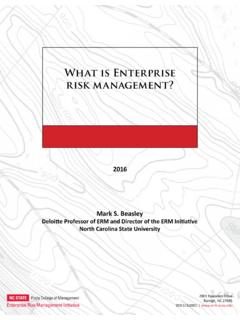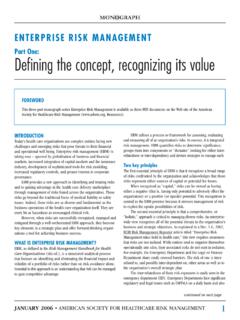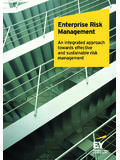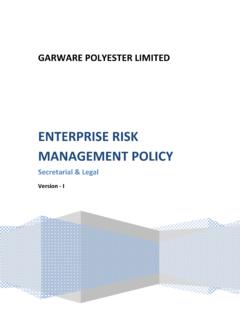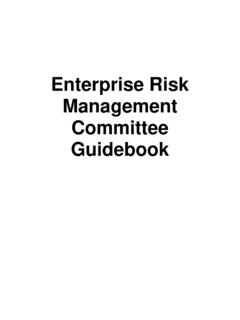Transcription of Enterprise Risk Management - EWU
1 EWU Policy 201-04 November 18, 2016 1 Enterprise Risk Management University Operations Administration EWU Policy 201-04 Authority: Board of Trustees Effective: November 18, 2016 Proponent: Vice President for Business & Finance Purpose: This policy describes Eastern Washington University s approach to managing risk while providing excellence in academics, student and employee opportunity and support, and community engagement. It is the policy of EWU to proactively assess and respond to any risks that may affect the achievement of EWU s mission, goals and objectives. This policy is implemented through EWU s Enterprise Risk Management Program (ERM). History: This policy supersedes Interim EWU Policy 201-04, dated August 30, 2016. It was adopted by the Board of Trustees on November 18, 2016. Applicability: This policy pertains to all functions and operations at Eastern Washington University.
2 CONTENTS Chapter 1 Introduction Chapter 2 Risk Control and Management Chapter 3 Responsibilities Appendix A References and Related Publications CHAPTER 1 INTRODUCTION 1-1. General The university recognizes that there is exposure to risk inherent in its programs and activities. It is university policy for every employee to act to reduce risk to the greatest extent feasible, consistent with carrying out of the mission and goals of the university. This policy provides administrative information and establishes compliance standards for Enterprise risk Management at Eastern Washington University. Enterprise Risk Management is a holistic approach to risk Management and encompasses risks related to all university activities including strategic, operational, compliance, financial, reputational, safety, etc.
3 Enterprise Risk Management proactively identifies risks and opportunities across all university programs, departments or divisions. The impacts of risk or opportunities are considered not in isolation, but rather, in relation to all other agency programs and risks . This avoids departmental silos. To achieve a mature Enterprise Risk Management program, Eastern Washington University will support and implement through its managers, supervisors and employees, coordinated Enterprise Risk Management guidelines, standards, and procedures which include, but are not limited to, the following elements: Including risk consideration as an integral part of the decision-making process. Analysis of the likelihood (frequency) and impact (severity) of risks . Identification and prioritization of risk on an university-wide basis.
4 Identification and implementation of possible risk mitigation strategies in a risk register or risk mitigation plan . 1-2. Enterprise Risk Management Program Objectives The university coordinates with the Department of Enterprise Services Office of Risk Management in the development of the university's Enterprise risk Management program. The objectives of the Enterprise Risk Management program are to: promote university-wide awareness through education training and information sharing, allocate resources to the greatest extent feasible to services for which the state is at greatest risk of liability with the goal of preventing or mitigating loss while meeting service expectations and responsibilities, identify and analyze loss exposure and safety hazards, develop and select techniques or combinations of techniques for addressing risks , implement effective administration of each risk Management plan , and, monitor the results produced or achievement of change.
5 Enterprise RISK Management EWU POLICY 201-04 EWU Policy 201-04 November 18, 2016 2 CHAPTER 2 RISK CONTROL AND Management The university manages exposure as an inter-related risk portfolio prioritizing loss prevention by assessing all areas of agency exposure to risk. Risk Management includes actions taken both before and after a loss occurs and is directed towards reducing risks and reducing the frequency and severity of losses. When analyzing a loss exposure, the impact on the entire campus, as well as on individual departments, is evaluated. 2-1. Risk Control Methods It is the responsibility of each unit and its personnel to conduct the business of the university in such a way as to reduce or prevent risks to the university and to evaluate the risk cost potential when determining whether to authorize new projects, activities, or programs.
6 The University uses various combinations of the following methods to manage risks to the institution. a. Risk Avoidance. The university may elect to avoid undesirably high risks and programs with excessive costs by refusing to undertake unsafe activities or by discontinuing high-risk programs. In cases where the university does not have the choice to stop providing a service or program, it may be able to change how a service is delivered to avoid a risk. b. Accept and Monitor. This option requires the university to develop measures to track whether the risk gets better or worse over time. If the university has very low control over a risk (such as national economic conditions or natural disasters), this can be the best treatment choice. c. Reduce the Likelihood. Treatment should focus on making it less likely that the risk will happen by reducing the conditions that cause the risk (such as deicing a sidewalk), imposing rules to control behaviors (such as prohibiting alcohol consumption), or limiting the amount of exposure to the risk (such as limiting the amount of time a person may be exposed to potentially harmful vapors).
7 D. Reduce the Impact. This option aims to reduce the impact an adverse event would have on the university s ability to achieve its goals. This can be achieved by planning for various contingencies or isolating potential risks . If the goal, for example, is to keep all university confidential information secure, then requiring password encryption of confidential information on all laptops will lessen the impact on the goal if a laptop is lost or stolen. e. Risk Transfer. Risk can be transferred either through an insurance policy or a contract that requires another entity to assume the risk. See section 2-2. Risk Financing Methods a. Risk Retention. The University often retains financial responsibility for its risks of accidental loss to the maximum extent possible without jeopardizing the financial position of the University or the continuation of essential programs.
8 risks may be retained through either pre-funded (self-insurance) or post-funded (noninsurance) programs, after evaluation of the risk exposure. Self-insured programs are funded through contributions to the Self-Insurance Liability Fund managed by the Department of Enterprise Services, Office of Risk Management . See RCW et. seq. and RCW et. seq. b. Risk Transfer. The financial responsibility for risks may be transferred to others through contractual agreements or through the purchase of insurance. Risk can be transferred contractually through a variety of mechanisms. For example, a person seeking to participate in an event on campus may be required to sign a contract assuming the risks of participating in the event and releasing the university from any liability associated with the event.
9 A contractor or vendor may be required, by contract, to assume certain risks associated with performing certain services or providing certain goods and to indemnify the university for any harm arising out of the contractor or vendor s performance. There are other contractual risk transfer mechanisms available, such as performance bonds, escrow accounts, and mandating certain types of insurance coverage. Any person entering into a contract on behalf of the university should be familiar with these risk transfer options. Insurance is another form of transferring risk. The Risk Manager may require departments, programs, student groups, or outside entities to purchase insurance at their expense before an activity is approved. The Risk Manager may also choose to purchase insurance on behalf of the university when it is not deemed prudent to retain the risk based on comparison of the cost of insurance with the risk Enterprise RISK Management EWU POLICY 201-04 EWU Policy 201-04 November 18, 2016 3 potential.
10 Further, the University may purchase insurance when required by law, bond, or contractual agreement, when real properties are financed with student fees or other non-state appropriated funds, or when non-university property is under the care, custody, or control of the University. Commercially insuring risks does not alter the responsibility of the University, its units, or personnel for compliance with required and appropriate safety/security standards. CHAPTER 3 RESPONSIBILITIES 3-1. University Leaders & Managers Leaders have a significant role to play in the Management of risk. That role is to set the tone and influence the culture of risk Management within the university. This includes: Determining risk tolerance, that is whether the agency is risk taking or risk averse as a whole or on any relevant individual issue; Determining which risks are acceptable and which are not; Setting the standards and expectations of staff with respect to conduct and risk inquiry; Monitoring the Management of mission-critical risks ; Satisfying itself that the less mission-critical risks are also being actively managed by staff who are risk owners and that there are appropriate and effective controls in place; and Reviewing annually the agency s approach to risk Management , losses in the previous year, and approving changes or improvements to key elements of risk assessment processes and procedures.


